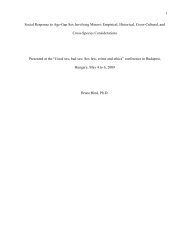Infant and Child Sexuality: A Sociological Perspective - Ipce
Infant and Child Sexuality: A Sociological Perspective - Ipce
Infant and Child Sexuality: A Sociological Perspective - Ipce
You also want an ePaper? Increase the reach of your titles
YUMPU automatically turns print PDFs into web optimized ePapers that Google loves.
According to the middle class st<strong>and</strong>ard, the infant is expected to<br />
sleep alone, preferably in his own room. Housing the infant away from<br />
the mother started in American hospitals only about sixty or seventy<br />
years ago. Many hospitals still practice separation of infant <strong>and</strong><br />
mother at birth, except for brief feeding encounters. When infant <strong>and</strong><br />
mother return home, the “ideal” pattern has been for the infant to<br />
spend much of his time alone in his room.<br />
It is reasonable to assume that there is in the United States a<br />
preoccupation with words <strong>and</strong> the articulated part of the culture rather<br />
than with touch. There is an attitude of prudery <strong>and</strong> anxiety about<br />
physical contact <strong>and</strong> erotic matters. With this assumption in mind, Clay<br />
(1968) observed the behavior of 45 children <strong>and</strong> their mothers at three<br />
public beaches patronized by persons of different social classes. One<br />
of the patterns he observed was the lack of contact between infant <strong>and</strong><br />
mother on the beach. The majority of encounters between infant <strong>and</strong><br />
mother were of two kinds: first, taking care of the infants, <strong>and</strong>, second,<br />
controlling their behavior. Far less frequent were intimate contacts<br />
expressing love <strong>and</strong> attachment. Parents reward “desexualized”<br />
motor performance that keeps the infant away from the mother. This generally<br />
applied, though girl children received more physical touches<br />
than did boys, <strong>and</strong> they were in physical contact with their mothers<br />
longer than were the boys. For mothers of young children, having a good<br />
time at the beach did not appear to include mothers enjoying their offspring<br />
in a direct, personal, affective, tactile, sensual encounter.<br />
The upper- <strong>and</strong> working-class mothers were more inclined to comfort<br />
their children with tactile contacts, while middle-class mothers offered<br />
distractions, mostly food. Middle-class mothers seemed more interested<br />
in meeting friends at the beach than in relating to their<br />
children. Small children are expected to play alone away from the parents.<br />
These observations <strong>and</strong> conclusions must be regarded as suggestive<br />
rather than definitive, however.<br />
Another area of infant-adult encounter that has great potential for<br />
educating the child in sexual matters is toilet training. There are important<br />
adult values, attitudes <strong>and</strong> behavior patterns which the infant<br />
learns in connection with toilet training. In the United States, one of<br />
these is the value placed on cleanliness. The infant is expected to<br />
keep himself <strong>and</strong> his clothes from being soiled when he urinates or defecates.<br />
His waste matter must go into the proper container <strong>and</strong> he must<br />
“wipe” himself so that no spots or odors cling to him. The mother may<br />
instruct him to wash his h<strong>and</strong>s after urinating or defecating to get rid<br />
of the “germs.” <strong>Child</strong>ren’s attitudes of disgust toward the texture,<br />
color, <strong>and</strong> odor of feces develop only after socialization by a mother<br />
who expresses such attitudes. (Sears, et al, 1957, p. 106-107).<br />
Looking for relationships between toilet-training patterns <strong>and</strong> the<br />
mother’s sexual anxiety or strictness of attitude toward control of<br />
sexual behavior, Sears (Sears, et al, 1957, p. 111) found that toilet<br />
training <strong>and</strong> control of sexual behavior were frequently linked by the<br />
mothers. If eliminating had sexual implications for mothers, one can<br />
hypothesize that her degree of sexual anxiety might influence her toilet<br />
training patterns. The assumption is all the more reasonable since<br />
high sexual anxiety has been found to be associated with the decision<br />
not to suckle. If the mother had sexual anxiety over toilet training,<br />
she might consciously or unconsciously try to get it over with as early<br />
16
















